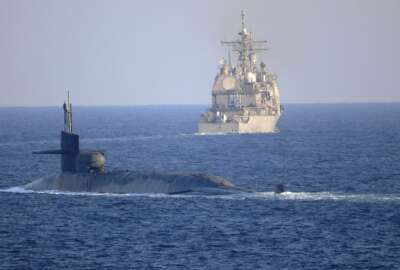
Service members in remote areas missing out on transition benefits
DoD's Transition Assistance Program aims to prepare service members for life outside the military. But for members whose final duty station is small or rural, the...
The DoD Reporter’s Notebook is a weekly summary of personnel, acquisition, technology and management stories that may have fallen below your radar during the past week, but are nonetheless important. It’s compiled and published each Monday by Federal News Network DoD reporters Jared Serbu and Scott Maucione.
Small bases and installations in remote areas are having trouble providing important transition benefits to service members leaving the military.
Compounding the problem is issues related to COVID-19, where even more programs are delayed or congested, according to the Government Accountability Office.
The Transition Assistance Program (TAP) is a cohesive, modular, outcome-based program that bolsters and standardizes the opportunities, services and training that service members receive to better prepare them to pursue their post-military career goals, according to the Defense Department website. It’s considered an essential benefit for many service members who only know professional life within the military.
GAO found that small and remote bases had limited local employment opportunities for transitioning service members.
“Officials whom we interviewed at six installations said that employment opportunities in the local area are limited, which can affect the networking opportunities service members have when searching for post-military employment,” the GAO investigators wrote.
The nature of living on a small base was also found to be a hindrance, GAO stated that at times bases could not hold in-person classes because they did not have enough service members for a minimum class size.
“As a result, the class has to be cancelled or postponed and the service member has to wait for the next offering or take the class at another installation or virtually, depending on their transition timeline,” the authors wrote. “An official at one of the Navy installations in our review said that the installation faced the same issue with virtual classes during the pandemic.”
Even the remoteness of the bases can be an issue. Officials at two mountain-based bases said that at times TAP instructors could not reach the base because of topography or inclement weather.
COVID made things worse.
“Officials at six of the installations in our review said that the VA did not offer live virtual instruction for the veterans benefits briefing after the start of the COVID-19 pandemic,” the authors wrote. “Therefore, the only way for service members to complete the VA benefits requirement was through self-paced virtual learning.”
GAO noted that the number of service members using TAP services virtually resulted in challenges with platform licenses.
The Air Force said that it saw a slight decrease in TAP compliance at the start of the pandemic.
Remote bases are installations 50 miles or more from a city of 50,000 and small bases are ones with 10,000 service members or less.
GAO is not making any recommendations for improvement at this point. — SM
Worldwide military experiments show AI capabilities for global integration
The military combatant commands and NORAD finished their third set of experiments aimed at using artificial intelligence to warn decision makers of threats earlier.
The experiment was conducted in conjunction with the Defense Department’s Joint Artificial Intelligence Center (JAIC) in what the military is calling a series of risk-reduction experiments.
“The Global Information Dominance Experiment 3 (GIDE 3) showcased how the software tools designed for cross-combatant command collaboration, assessment, and decision-making can be used to enable more effective global logistics coordination, intelligence sharing and operations planning,” Gen. Glen VanHerck, the commander of NORAD and U.S. Northern Command said in a statement. “By integrating more information from a global network of sensors and sources, using the power of AI and machine-learning techniques to identify the important trends within the data, and making both current and predictive information available to commanders, NORAD and NORTHCOM are giving leaders around the globe more time to make decisions and choose the best options available, whether in competition, crisis or conflict.”
The system is just one way DoD is making an effort to inject AI measures into almost every facet of its future capabilities.
“Integrated deterrence is about using the right mix of technology, operational concepts, and capabilities — all woven together in a networked way that is so credible, flexible and formidable that it will give any adversary pause,” said Defense Secretary Lloyd Austin.
GIDE 3 showed JAIC’s Matchmaker capability of recognizing crisis deterrence and defense options and presenting them to decision makers across the globe so they could make integrated decisions.
The previous experiments set up more early-warning and processing capabilities for AI systems to take in.
Stage one focused on cost-effective data solutions to increase decision space through earlier indications and warnings. Stage two evaluated the ability to respond to contested logistics and demonstrated global collaboration to rapidly create deterrence options and dynamic contested logistics planning, according to the Air Force.
“Our nearly two-year experimentation partnership with NORAD and U.S. Northern Command on three of our five events has yielded tremendous progress in designing and evaluating and the technical architectures that enable our joint warfighters,” said Preston Dunlap, the Air and Space Forces’ chief architect. “We’re grateful to have willing and motivated partners like NORAD and NORTHCOM who are eager to get after the difficult decision superiority for strategic leadership challenges, all the way down to agile, distributed decision superiority at the edge problem sets that we tackled in GIDE 3.” — SM
Copyright © 2025 Federal News Network. All rights reserved. This website is not intended for users located within the European Economic Area.
Scott Maucione is a defense reporter for Federal News Network and reports on human capital, workforce and the Defense Department at-large.
Follow @smaucioneWFED




